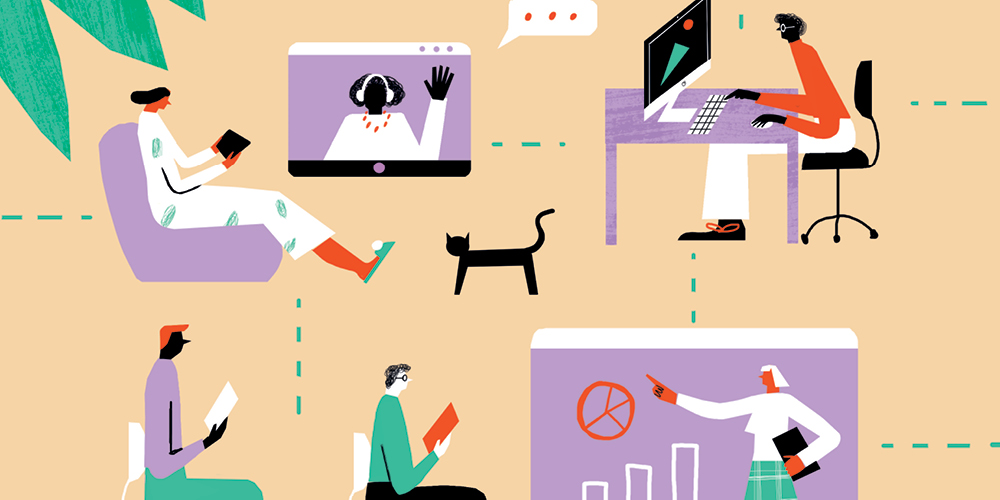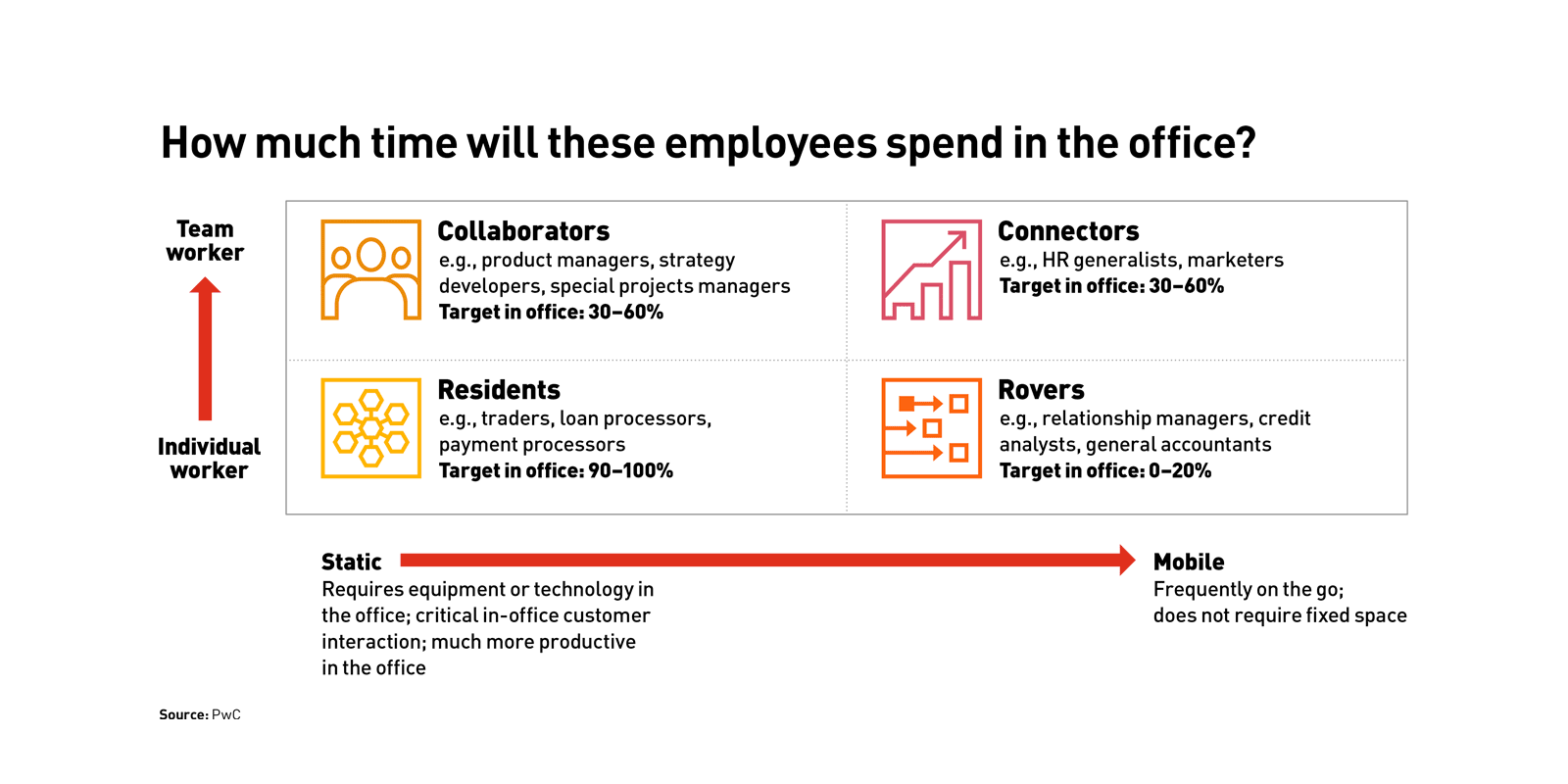Creating the office of the future
In a remodeled world, it is vital for companies to reinvent ways of working.
A version of this article appeared in the Winter 2020 issue of strategy+business.
The corporate office is on the brink of a major renovation. The lockdowns that began in the U.S. in mid-March in response to the novel coronavirus created an extraordinary migration as employees across the country began working at home. People patched together ways to keep going when the lights went off in office buildings, and, for the most part, it has worked: In the June 2020 PwC US Remote Work Survey, three out of four employers called work from home (WFH) a success.
It’s no surprise, then, to find widespread interest in maintaining some form of WFH once the pandemic recedes. Everybody benefits. Employees avoid lengthy commutes and spend more time with their family. Employers have access to talent regardless of location, improve resiliency through a distributed workforce, and reduce expenses by optimizing their real estate footprint. Even the environment gets a break thanks to fewer people commuting, less business travel, and less heating and cooling of office space. The Remote Work Survey shows that 73 percent of employees would like to work remotely at least two days a week, even once COVID-19 is no longer a concern. Similarly, 55 percent of executives are prepared to expand options for employees to work outside the office.
This turnabout in perspectives is striking. The prevailing view just a few months ago held up the office as a strategic asset to appeal to a new generation of workers located in urban areas, with open-space designs and room to play. Today, skeptical executives who believed employees could not be productive away from the office have come around, or at least have softened their views, and see that working from home can be effective. Now many large companies across industries have announced their intent to let employees work from home at least part of the time going forward.
As a flexible WFH model appears likely to become the norm, the role of the corporate office and its physical footprint are coming under scrutiny. Right now, almost all office workers are working remotely. Will we see the same level of collaboration and productivity when some are in the office and others at home? We’re all leveraging relationships that we have built in the office through the years; how do we build new networks when veteran employees leave and new employees are hired?
As a flexible work-from-home model appears likely to become the norm, the role of the corporate office and its physical footprint are coming under scrutiny.
The pandemic has shown that the real prize in remote work is not reducing real estate costs — it’s fostering a stronger sense of resiliency. In the future, remote work will also allow greater access to a diverse pool of talent, regardless of where it is located. Our surveys show a small percentage of employees prefer to work remotely all the time, so it’s important to assess what flexibility means for them. Meanwhile, other employees will want to socialize with team members and feel that they are part of the organization. How many people will need a place to collaborate with colleagues in person, and how often?
The answers to these questions will determine both the success of a business and the extent of the physical remodeling that companies will need to do. As leaders think about the role of their corporate offices and how and where their employees work once coronavirus concerns recede — whether it is this year or further in the future — they must clearly define the reasons for employees to return to the office.
Four actions to transition to the office of the future
No solution works for every company. Executives will need to figure out their own path, given the scale of potential changes. But these four steps will help.
1. Redefine the role of the office
Start by defining the purpose of the office in your organization. Go through a careful evaluation of what happens in your spaces. What is valuable enough to keep your people coming in? A significant number of companies outside the manufacturing sector have shown they can work from home effectively, so pinpoint the reasons people need to come back to the office. Indeed, the office may be evolving from a default location where employees go to get their work done to a destination employees visit for specific purposes.
Consider the work that people do. We call this exercise the Six Cs. Each C can be mapped to give employers an idea of physical and productivity space needs.
Creating work products: Analyzing data, doing research, processing orders, and writing documents. These “heads-down” tasks are often performed individually, and largely can be done independent of an office location as long as the employee does not require specific equipment or physical documents tied to the office.
Collaborating: Brainstorming ideas, developing plans, and solving problems with colleagues. Collaborating with colleagues was one of the top reasons many employees went to the office, according to PwC’s Remote Work Survey. Working from home during the pandemic has highlighted forms of collaboration that can still be effective when participants are not together in person. When does being “in person” make a measurable difference?
Communicating: Sharing information, giving status updates, asking for or providing feedback, and answering or following up with clients. Many communications can (and now do) take place over video, email, chat apps, or the phone. Again, when does communicating “in person” make a difference?
Coaching: Developing employees and providing feedback. Prior to the pandemic, coaching was often done face-to-face. However, because it’s largely a one-on-one exercise, most coaching could be virtual.
Committing: Making decisions and committing to actions. Commitments are often determined in formal settings, such as steering committee meetings, and sometimes in discussions among peers or between a manager and an employee. How and when do commitments happen in a given organization?
Community building, or corporate culture: Forming relationships through daily interactions. Some of these interactions purely involve work, but not all. Social activities help colleagues get to know one another as individuals and form relationships that benefit the work environment.
Although the last several months have shown that almost all of these activities can happen virtually at least some of the time, in the longer term, a portion of them will also take place in the office. So how will the split evolve? Once leaders have mapped what their workforces do, how much time they take to do it, and where being physically present adds value and boosts results, they can plan not only the size but the layout of their offices.
The creation of work products, as defined above, can largely move away from the office — and so can communicating, via virtual conference calls or team updates. Much of coaching can be handled virtually, too. Collaborating, committing, and community building, however, are team engagements at their core. Although much of that engagement can be virtual, in-person engagement is most valuable for these activities.
2. Define work-from-home guidelines
Our Remote Work Survey anticipates a flexible WFH model in which employees work in the office a few days per week once COVID-19 is no longer a concern. This generality, however, will apply to employees differently depending on their specific roles, with tailored approaches for greater workweek flexibility. When planning, it can help to create specific employee personas and map their activities, requirements, and propensities for home or office working based on the Six Cs.
Here we’ve divided these employees into four groups: collaborators, connectors, residents, and rovers, and have estimated the target time they would spend in an office.
Collaborators work in teams, but not necessarily in an office space. Think of research scientists, project managers, engineers, or designers. They may need powerful computers or access to specific equipment. And there are times when being together in person is more productive, such as a creative visioning session. Yet, as routine meetings and status checkups increasingly take place virtually, their need for time on premises could decrease significantly.
Connectors are typically the corporate support staff, including IT developers, marketing and public relations professionals, accountants, and human resource specialists. They have varying working patterns and can work in multiple areas within a company location. They work at their desks and in conference rooms. Target times on premises could decline by as much as two-thirds with enhanced remote working tools.
Residents are the traders, engineers, loan processors, and designers who need specific equipment, customized terminals, or powerful computers in the office to do their job. They work alone frequently but may require a specific space and specific tools. Mobility for this group will be more limited.
Rovers — the client-side consultants or sales executives — also work alone frequently, but they can work anywhere. Reducing expectations for their need for office time to as little as 10 percent is not unreasonable — that would mean two days a month in the office. This is likely to have been close to normal for some rovers even before COVID-19.
3. Remodel the office
According to the analysis above, the office of the future is primarily a space for collaboration and community building, though some tasks do require individual work spaces. Few floor plans are ready for this focus now, and given the pandemic hiatus, the remodeling that is currently going on is working in the other direction: Executives at many companies are retrofitting their offices with a “safety first” mind-set, putting up social-distancing barriers to shield people from one another and reducing the office capacity to half or even less of what it was before the pandemic.
For the office to serve its new and more specific future purpose of enabling collaboration and community building, a different kind of major remodeling is ahead. We anticipate that assigned offices and desks, that is, spaces reserved for individual work, will shrink significantly and be converted into unassigned, hotel-type seating arrangements with less square footage per seat than is the case today. In return, space for socializing and collaborating will increase. Huddle rooms will prompt ad hoc collaboration of two to four people; larger conference rooms will host decision-making meetings; hubs will enable project teams to work together. These collaboration spaces will be equipped with tools and technology to enhance the experience. For example, team hub rooms will be configured with “white walls” for brainstorming and powerful videoconferencing technology for seamlessly patching in remote team members.
Once a business maps its groups, it will have a better sense of what is needed in a physical office. Suppose your rovers need to be in the office 10 percent of their time or one day every two weeks: If you have 1,000 rovers, that translates into 100 seats. Now factor in density, or the total space needed for a group. Different groups will use the office space differently and thus will need different types of spaces. Many companies will need significant renovation and an investment in hoteling and basic space reservation systems, as well as phone routing systems.
One final consideration: As a result of the pandemic, some companies are questioning whether to diversify from a single, large office in a major urban center to a hub-and-spoke model, with one or two offices in urban locations and a handful of outposts in the suburbs. The outposts may shorten commutes for suburban workers while still enabling collaboration and enhancing business continuity. In addition to owning or leasing dedicated offices, companies may consider coworking spaces in order to increase flexibility and access for their much more mobile workers.
4. Update your ways of working
Companies that want to make an office-wide shift to flexible remote work will fail if they do not define how ways of working will change in this new model. Pre-pandemic, policies, processes, and the implicit and routine ways of working were defined with an assumption that most of the workers were in the office most of the time. Now that a large number of corporate employees are working from home, those assumptions have already gone out the window, and legacy ways of working have become insufficient or even obsolete.
Office-centric ways of working institutionalized how employees engaged with each other, and collaboration and innovation would often occur organically in hallways or over coffee. (Bell Labs figured that out in the 1950s and designed corridors specifically to let people bump into one another.) Only a third of U.S. workers in PwC’s June 2020 Workforce Pulse Survey rated the tools and resources for collaboration and communication in their organization as “very effective.”
Yet the flexible work arrangements everyone has been using to cope with the pandemic are redefining these norms. As a result, you will need to deliberately establish ways of working that allow for serendipity but don’t risk teams settling into recently improvised ways of working that can create confusion and frustration. These new ways of working benefit the employees not only in the short term but also in the longer term as they develop new skills and enhance their own employability. To define these new ways of working, the following elements are needed.
Standards and guidelines. Establish the parameters of work for regular activities. Set standards for when people are available and how key performance indicators are reported and measured. Outline what a successful meeting looks like and how action points are allocated and reported.
Routines. Remote working requires specific routines, depending on what people do. Some teams need daily huddles, others weekly catch-ups. Social events can also be programmed.
Tools and technology. The infrastructure of remote collaboration was cobbled together for the pandemic. Some companies had protocols in place and robust file-sharing capabilities. Others did not. These technologies will now have to be standard, secure, and straightforward to use.
Risk and controls. Data protection is always top of mind, but in a remote working environment, the cracks are all too evident. If the company email system fails or a file transfer system crashes, work-arounds using personal email accounts can severely compromise corporate data. And considering how many people are accessing systems and trying hard to do their jobs, keeping tabs on these activities is not easy. Companies are scrambling to keep up. Given that cybersecurity and data protection will remain a top priority, getting this right now should be an urgent concern.
For example, consider how a manager coaches an employee in a mobile world. The manager will need new standards and guidelines that outline what good coaching and feedback look like. He or she may define new routines that call for daily check-ins and feedback on the quality of the work product; monthly 30-minute one-on-ones to focus on the employee’s performance and career development; and a midyear check-in for a more comprehensive progress review.
The office and ways of working as we have known them are gone. In their place, we have a rare opportunity to redesign where and how we will work. The view will be worth the climb: On the other side, we can provide employees with better experiences and help them acquire skills they can take with them through their career. We can reconfigure our spaces to ensure collaboration, innovation, and productivity, and reduce operating expenses. We can build in more diversity and inclusion and increase environmental sustainability. The lead time is long — it could be two to three years — to plan for the new footprint, find new sites, remodel the offices for the company’s needs, and transition. So the time to start planning is now. Let the remodeling begin.
Author profiles:
- Deniz Caglar is an advisor to executives on strategic cost and organizational transformation for Strategy&, PwC’s strategy consulting business. Based in Chicago, he is a principal with PwC US. He is a leader in the PwC US organization strategy practice and coauthor, with Vinay Couto and John Plansky, of Fit for Growth: A Guide to Strategic Cost Cutting, Restructuring, and Renewal.
- Edward Faccio advises organizations on corporate real estate strategy and transformation, and helps leadership teams align their business operations with new ways of working. Based in New York, he is a partner with PwC US.
- Erika Ryback advises organizations on corporate real estate strategy and transformation. She works with businesses to execute real estate strategies using enabling technology. Based in New York, she is a director with PwC US.
- Also contributing were Bhushan Sethi, a principal with PwC US and joint global leader of PwC’s people and organization practice; Vinay Couto, a principal with PwC US and leading practitioner in people and organization strategy; PwC US director Sid Bhatia of the Workforce of the Future team; Ashish Jain and Augusto Giacoman, both principals with PwC US; and PwC’s US real estate practice leader Byron Carlock.






